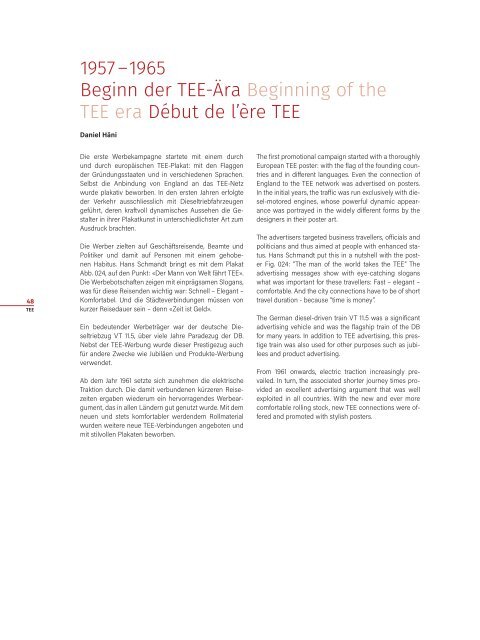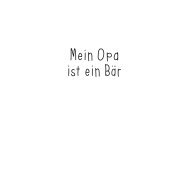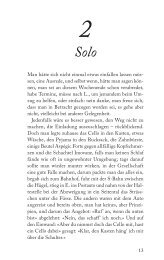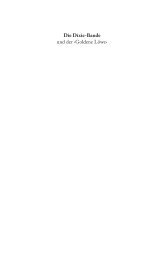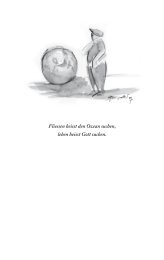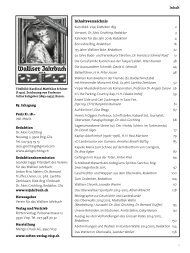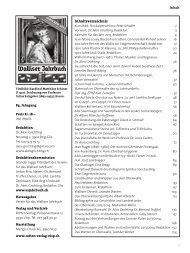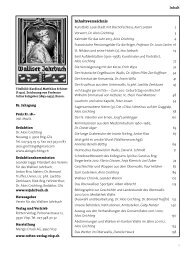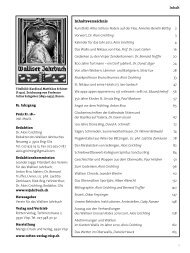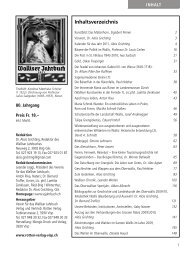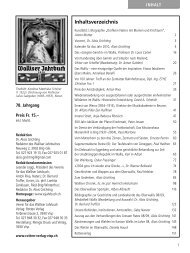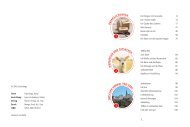TEE-Plakate_Leseprobe
You also want an ePaper? Increase the reach of your titles
YUMPU automatically turns print PDFs into web optimized ePapers that Google loves.
1957 – 1965<br />
Beginn der <strong>TEE</strong>-Ära Beginning of the<br />
<strong>TEE</strong> era Début de l’ère <strong>TEE</strong><br />
Daniel Häni<br />
48<br />
<strong>TEE</strong><br />
Die erste Werbekampagne startete mit einem durch<br />
und durch europäischen <strong>TEE</strong>-Plakat: mit den Flaggen<br />
der Gründungsstaaten und in verschiedenen Sprachen.<br />
Selbst die Anbindung von England an das <strong>TEE</strong>-Netz<br />
wurde plakativ beworben. In den ersten Jahren erfolgte<br />
der Verkehr ausschliesslich mit Dieseltriebfahrzeugen<br />
geführt, deren kraftvoll dynamisches Aussehen die Gestalter<br />
in ihrer Plakatkunst in unterschiedlichster Art zum<br />
Ausdruck brachten.<br />
Die Werber zielten auf Geschäftsreisende, Beamte und<br />
Politiker und damit auf Personen mit einem gehobenen<br />
Habitus. Hans Schmandt bringt es mit dem Plakat<br />
Abb. 024, auf den Punkt: «Der Mann von Welt fährt <strong>TEE</strong>».<br />
Die Werbebotschaften zeigen mit einprägsamen Slogans,<br />
was für diese Reisenden wichtig war: Schnell – Elegant –<br />
Komfortabel. Und die Städteverbindungen müssen von<br />
kurzer Reisedauer sein – denn «Zeit ist Geld».<br />
Ein bedeutender Werbeträger war der deutsche Dieseltriebzug<br />
VT 11.5, über viele Jahre Paradezug der DB.<br />
Nebst der <strong>TEE</strong>-Werbung wurde dieser Prestigezug auch<br />
für andere Zwecke wie Jubiläen und Produkte-Werbung<br />
verwendet.<br />
Ab dem Jahr 1961 setzte sich zunehmen die elektrische<br />
Traktion durch. Die damit verbundenen kürzeren Reisezeiten<br />
ergaben wiederum ein hervorragendes Werbeargument,<br />
das in allen Ländern gut genutzt wurde. Mit dem<br />
neuen und stets komfortabler werdendem Rollmaterial<br />
wurden weitere neue <strong>TEE</strong>-Verbindungen angeboten und<br />
mit stilvollen <strong>Plakate</strong>n beworben.<br />
The first promotional campaign started with a thoroughly<br />
European <strong>TEE</strong> poster: with the flag of the founding countries<br />
and in different languages. Even the connection of<br />
England to the <strong>TEE</strong> network was advertised on posters.<br />
In the initial years, the traffic was run exclusively with diesel-motored<br />
engines, whose powerful dynamic appearance<br />
was portrayed in the widely different forms by the<br />
designers in their poster art.<br />
The advertisers targeted business travellers, officials and<br />
politicians and thus aimed at people with enhanced status.<br />
Hans Schmandt put this in a nutshell with the poster<br />
Fig. 024: “The man of the world takes the <strong>TEE</strong>” The<br />
advertising messages show with eye-catching slogans<br />
what was important for these travellers: Fast – elegant –<br />
comfortable. And the city connections have to be of short<br />
travel duration - because “time is money”.<br />
The German diesel-driven train VT 11.5 was a significant<br />
advertising vehicle and was the flagship train of the DB<br />
for many years. In addition to <strong>TEE</strong> advertising, this prestige<br />
train was also used for other purposes such as jubilees<br />
and product advertising.<br />
From 1961 onwards, electric traction increasingly prevailed.<br />
In turn, the associated shorter journey times provided<br />
an excellent advertising argument that was well<br />
exploited in all countries. With the new and ever more<br />
comfortable rolling stock, new <strong>TEE</strong> connections were offered<br />
and promoted with stylish posters.


